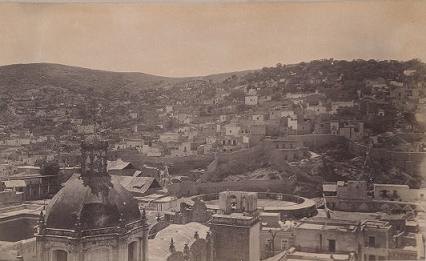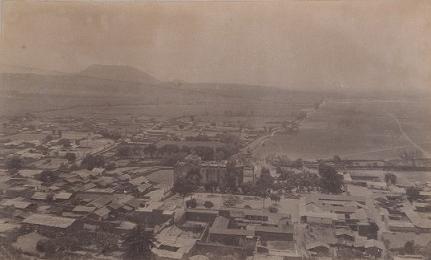| << Chapter < Page | Chapter >> Page > |
Mixteca men making rope
View of men and women in the park
At first glance, it just looks like men and women relaxing at the park. Zooming into the photo, though (see version on the OAAP site to zoom in), reveals men wearing sombreros and working outfits; not only that, but their juxtaposition with the upper class (women with their sun umbrellas and dresses and the men with their high-class suits and hats) makes this image interesting. This is a clear representation of the gap between the working class and the wealthy during the Porfiriato that partially influenced some revolutionary leaders during the Mexican Revolution.
Comparison of mexican neighborhoods
Rooftop view of a mexican neighborhood

Bird's eye view of neighborhood with church building and small buildings with tiled and thatched rooftops

Daytime view of a mexican street with rail car tracks, mules, gas streetlight fixtures, and vendors' stalls

Examples of photographs to include in class discussions:
Bird's eye view of neighborhood with church building and small buildings with tiled and thatched rooftops, in or near Mexico City . Photographs. 1890. From Woodson Research Center, Rice University , Charlotte and Maximilian collection, 1846-1927, MS 356. (External Link) .
Rooftop view of a Mexican neighborhood, possibly Mexico City . Photographs. 1890. From Woodson Research Center, Rice University , Charlotte and Maximilian collection, 1846-1927, MS 356. (External Link) .
Daytime view of a Mexican street with rail car tracks, mules, gas streetlight fixtures, and vendors' stalls. Photographs. 1890. From Woodson Research Center, Rice University, Charlotte and Maximilian collection, 1846-1927, MS 356. (External Link) .
Farm worker plowing field with two oxen, carriages and onlookers visible in background. Possibly near Mexico City . Photographs. 1890. From Woodson Research Center, Rice University , Charlotte and Maximilian collection, 1846-1927, MS 356. (External Link) .
Street level view with pedestrians, Zocalo, Mexico City . Photographs. 1890. From Woodson Research Center, Rice University , Charlotte and Maximilian collection, 1846-1927, MS 356. (External Link) .
View of railcar stopped along tree shaded road, passengers in formal dress, Mexico . Photographs. 1890. From Woodson Research Center, Rice University , Charlotte and Maximilian collection, 1846-1927, MS 356. (External Link) .
Street scene in Mexico featuring men and women walking on street and stair . Photographs. 1890. From Woodson Research Center, Rice University , Charlotte and Maximilian collection, 1846-1927, MS 356. (External Link) .
For more pictures, visit the Our Americas Archive Partnership website and type in keywords (such as Mexico City, Mexico, images, etc.) in the search box.

Notification Switch
Would you like to follow the 'Using historical documents' conversation and receive update notifications?